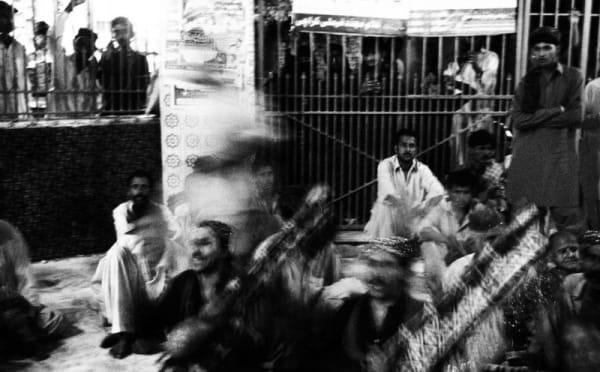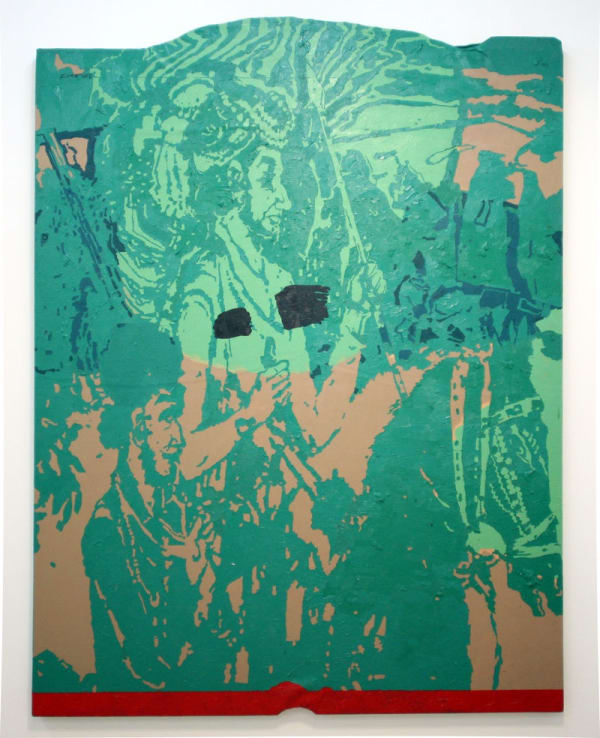Firoz Mahmud's works often draw artistic themes from the history of the Bangladeshi region in which he is deeply rooted, and where many historical cities have been transformed by colonialism. A distinct number of Mahmud's works look at Uponibeshik (colonial) and Poruponibeshik (post-colonial) narratives of Bangladesh and its capital city of Dhaka which was formerly known as Jahangir Nagar.
Mahmud coined the term 'Layapa Art' to describe his paintings that employ a technique that he researched on during a residency program at Rijksakademie VBK, Amsterdam in 2003/2004. The word 'Layapa' is from the Bengali language and means 'to anoint or plaster'. The women of rural Bangladesh use a meticulous technique to finish the walls of their village huts with clay. The artist sought inspiration from this as well as other cultural practices such as the Japanese Ukiyo-e woodblock printing. The end result is a hybridized stencil and layering technique which forms part of the foundation of Mahmud's art practice. Such aspects of cultural heritage may have gotten devalued or undermined through the mechanisms of colonialism that affected many nations from the 17th to the 20th centuries.
Mahmud's works are largely informed by his ongoing interest in historical narratives and artistic devices in story-telling. He uses idioms such as old palaces, forts, spice trees or herbaceous plants, wild animals and colonial traders in these drawings and carvings, addressing the riches of his native land. Mahmud juxtaposes themes of socio-political culture, tradition, history, and myths that beg the question of how they exist today, and what forces have created new visual territories, impacting how we remember our own cultural histories and those of our neighbours.
Firoz Mahmud (b. 1974) was born in Khulna, Bangladesh and completed his BFA and MFA at the Dhaka University's Institute of Fine Arts before attaining a PHD in Fine Arts from the Tokyo University of the Arts. He has completed residencies at the Rijksakademie VBK, Amsterdam, and the International Studio and Curatorial Program in New York. Mahmud’s paintings and installations examine the socio-political culture, tradition, history, myths and pop culture of his native land. His most notable works have been featured in group exhibitions at “HEAT” Ota Fine Arts, Tokyo (2017); “The Missing One” The Office for Contemporary Art Norway, Oslo, Norway (2016); "Aichi Triennale 2010: Arts and Cities", Aichi, Japan (2010); "The 9th Sharjah Biennial" Sharjah, UAE (2009); and "The 11th International Cairo Biennale" Cairo, Egypt (2008).
-

Firoz Mahmud "Art, Artists & You" Children's Museum, Manhattan, New York
14 Sep 2019Firoz Mahmud participates in 'Art, Artists & You' at Children's Museum, Manhattan, New York from 8th June to 31th December 2019. Exhibition Information Title :...Read more -

Firoz Mahmud "Vantage Point Sharjah 7" Sharjah Art Foundation, UAE
23 Jul 2019Firoz Mahmud participates in a group exhibition 'Vantage Point Sharjah 7' held at the Sharjah Art Foundation, UAE from 6th July to 6th October 2019....Read more -

Firoz Mahmud "Congo Biennale" the Democratic Republic of the Congo
23 Jul 2019Firoz Mahmud will participate in the 'Congo Biennale' held in the Democratic Republic of the Congo from 20th October to 21st November 2019. Exhibition Information...Read more -

Firoz Mahmud "Not Just Another Pretty Picture" Berkshire Art Museum, Massachusetts
12 Jun 2019Firoz Mahmud will participate in 'Not Just Another Pretty Picture' Berkshire Art Museum, Massachusetts from 27th June to 30th October 2019. Exhibition Information Title :...Read more






